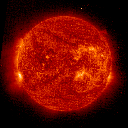Nightmare on Gum Street
 A map of Sandy Beach will show that some of the streets, such as Pine Crescent, Maple Road and Chestnut Avenue, have been named after non-native species. A Chestnut Avenue in Australia is like a Gumtree Avenue in England or the USA -- perhaps a nice tribute to globalism, but otherwise not highly relevant.
A map of Sandy Beach will show that some of the streets, such as Pine Crescent, Maple Road and Chestnut Avenue, have been named after non-native species. A Chestnut Avenue in Australia is like a Gumtree Avenue in England or the USA -- perhaps a nice tribute to globalism, but otherwise not highly relevant.Our naming of streets is reminiscent of our practices at Christmastime. I refer to the Australian 'cultural cringe' by which that which is native is considered less worthy than that which comes from the North. It just isn't Christmas in Oz without a Santa Claus sweltering in full winter gear on days when the tar is melting on the road. Melting, in fact, on roads named Elm, Pine and Chestnut more often than we should be proud of.
The trees that were here were seldom valued for their intrinsic values, but for their economic worth. I'm reminded of Oscar Wilde's saying that some people know the price of everything but the value of nothing. A tree was seen as either so many superfeet of timber, or something to turn into a stump which then had to be burned out to allow ploughing. The Australian motto, "If it moves, shoot it. If it doesn't, chop it down", should be engraved on our banknotes and emblazoned on our flag.
On the other hand, some of the local streets have been named after trees that do belong in the hinterland of Sandy Beach, but which are not so easy to find these days. Ironbark, Turpentine, Redbox, Acacia ... the trees haven't entirely disappeared, but, sadly, many people will know their names only from street signs. How many of us know what Sandy Beach might have looked like before the cattle grazers, banana farmers and real estate developers came in? I have to admit, it isn't that easy to imagine.
There would have been wetlands, but the farmers and developers, and no doubt the mapmakers, would have used the word 'swamp' for these. Behind the frontal dunes and back to the hills that now carry bananas would have been something like the relatively little relict forest that we've saved like a ship in a bottle for future generations, and which we call Moonee Beach Nature Reserve. It's a good idea to walk through that relic and get a feel for what Sandy was like, and how much better Sandy could have been designed for human habitation in concert with Nature. And maybe we won't keep making the same mistakes (though another such big mistake is on the drawing boards as I write).
Up and down the coast the story is the same. Maple Avenues and Elm Streets and mini-memorials to fallen forests. From about Kempsey north, stretching many hundreds of kilometres into Queensland, little more than a century ago was a huge cedar forest so dense that, we are told, to walk through it was scarcely to see the sky at any time through the canopy.
The cedar was all cut down (so now other species, many of them weeds, grow up) and shipped to Britain as the ballast in ships. There, our cedar was turned into building materials and furniture, mostly for the richer British people. Today, not only can you not find a cedar tree in Australia for love nor money, the prospect of finding a bit of cedar furniture is minimal except for the wealthy -- it's all in the UK, with a few ultra-expensive items remaining in a few mansions. (Sometimes, a poor bloke like me gets lucky and his grandfather bought a 19th-century Post Office cupboard and gave it to his young grandson back in the early '60s.)
It's a beautiful place, Sandy Beach, and was once a beautiful coastal forest. How easily and often do I forget. Just taking a flaneur around the village and looking at the street signs was a very good reminder.



















0 Comments:
Post a Comment
<< Home